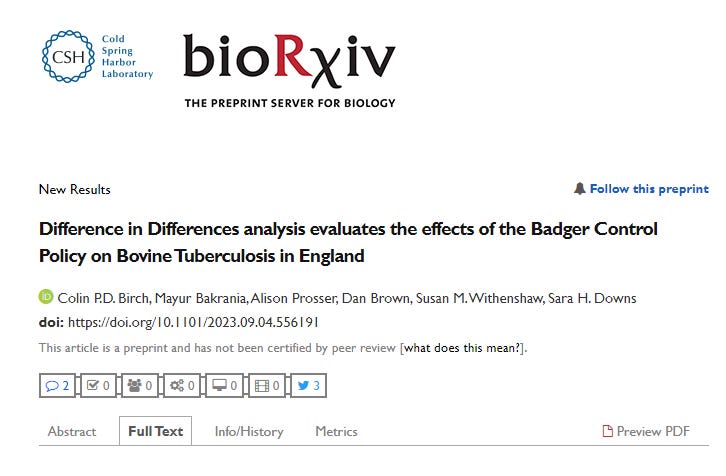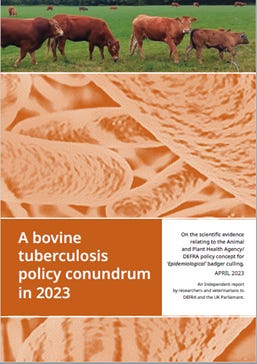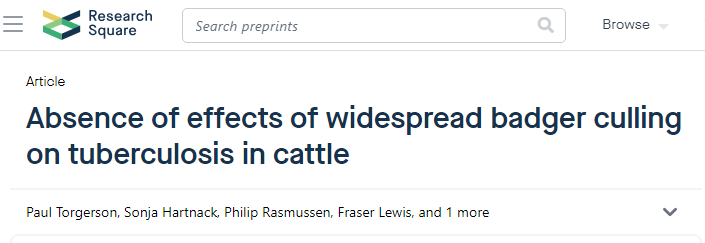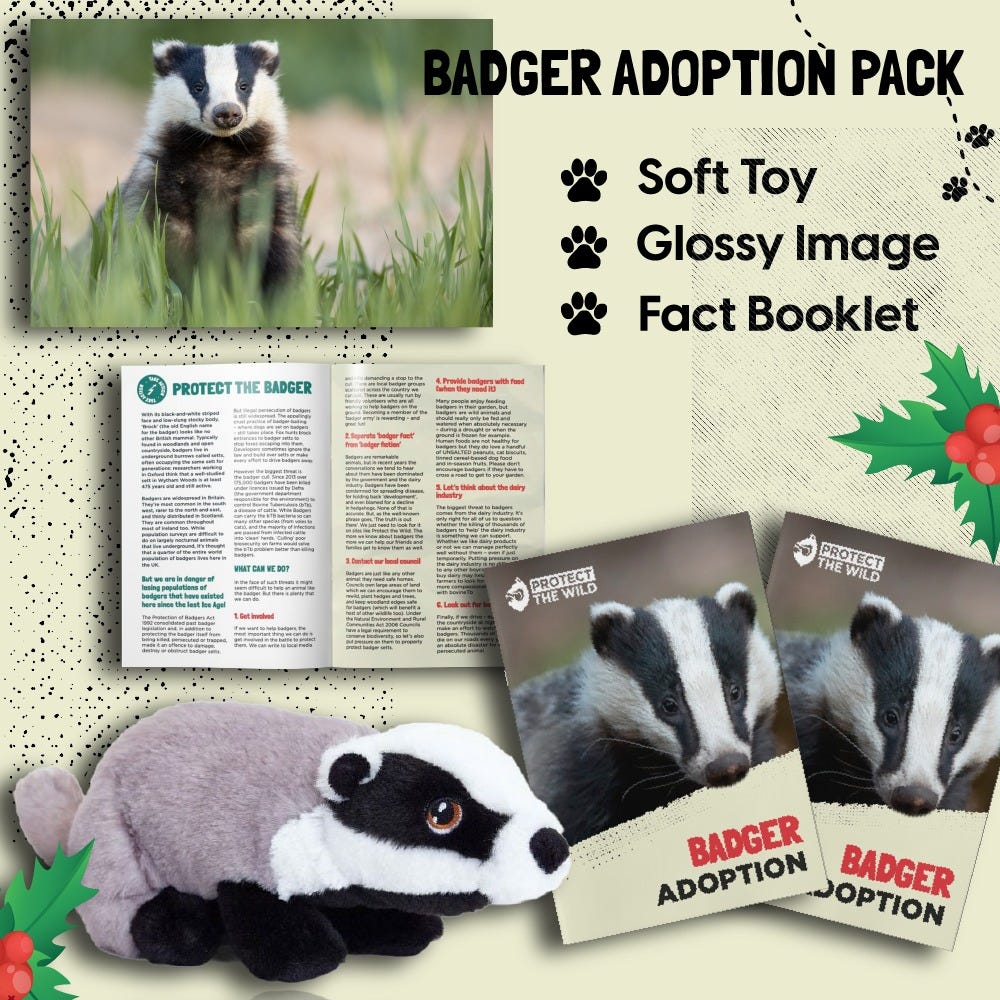A guest blog in collaboration with The Badger Crowd - reporting on badger cull science & legal challenges.

On 14th March 2024, Defra launched a 5-week consultation on the next steps to ‘evolve’ what they call ‘badger control policy’, a vague combination of cattle testing and badger killing that they conveniently confuse.
This would now overlap with and follow eleven years of intensive badger culling. The intensive culls have been in progress since the policy began in 2013, bringing the total killed to around a quarter of a million (2023/24 numbers have still not been released). Culled badgers have been predominantly healthy, killed on the premise of a hypothetical disease perturbation effect and supposed average 16% annual reduction in TB infections in cattle, a concept designed by mostly Oxford academics.
The recently published paper by Birch et al. is being used to justify further culling and claim that the culling programme thus far has been successful, with Environment Minister Steve Barclay stating “bovine TB breakdowns in cattle are down by on average 56% after four years of culling”. By sleight of presentation, he immediately confuses cause and effect. Authors of Birch acknowledge (on careful reading) that the overall result cannot be attributed either to badger culling or cattle measures; the different measures were analysed together and it is more likely to be cattle measures than badger culling because the decline began well before culling and in response to the introduction of annual SICCT testing in 2010.
Badger culls have previously been justified using the (now dumped) guess-based ‘Risk Pathways’ approach of the Animal Plant and Health Agency (APHA) that purports to explain how disease arrives in a herd. Its ‘tick-based’ veterinary questionnaires implicated badgers as the default primary source of disease when adequate information and investigation was lacking. Following the publication of ‘A bovine TB policy conundrum in 2023‘, in April 2023, (that led to the ‘dumping’), and with the speculative nature of their approach well exposed, APHA is now planning to use Whole Genome Sequencing (WGS) and the Badgers Found Dead Survey (BFD) to justify culling on a local basis. These two methods of pinning blame on badgers fall desperately short however, as they do not prove an exact route or rate of transmission from badger to cow. Badgers will just be getting bTB from cows as with 17z in Cumbria, rarely if ever giving it back.
In the new consultation, Defra are at pains to continue to refute a study in the journal Veterinary Record (18 March 2022) by Tom Langton and veterinarians Mark Jones and Iain McGill (Langton et al). They do this on the basis of an un-peer reviewed letter published at the same time, which used incorrect data and made incorrect assertions about the methodology used.
So where, 2 years later, is their measured alternative?
Nowhere, because they can’t produce anything, even holding all the data in secret as they do. There are many ways they could test the data, so why don’t they? Or have they tested it but don’t like the results? There has been no peer-reviewed rebuttal to Langton et al, and (following the change of DEFRA leadership from Richard Benyon to Robbie Douglas-Miller) Defra still refuse to engage on the matter. We have blogged about this sorry tale here and here and here.
Langton et al, done in the most logical and clear-cut way using all the data, shows what happens as unculled areas become culled, from 2013 onwards. It avoids the traps of multiple adjustments to attempt comparisons between completely different areas.
The paper has two main findings. The first is really good news for farmers, cows and badgers. Data suggests that the cattle-based measures implemented from 2010, and particularly the introduction of the annual tuberculin skin (SICCT) test are responsible for the slowing, levelling peaking and decrease in bovine TB in cattle in the High Risk Area (HRA) of England during the study period, all well before badger culling was rolled out in 2016.
The second finding came from a look at the amount of cattle bTB in areas that had undergone a badger cull and compared it with the amount of disease in areas that had not had culling. This was done over a six-year period 2013-2019, so before and after culling was rolled out. Multiple statistical models checked the data on herd breakdowns over time and failed to find any association between badger culling and either the incidence or prevalence of bovine TB in cattle herds. The models that most accurately fitted the data were those that did not include badger culling as a parameter, suggesting that factors other than culling (cattle testing) were more likely to be the cause of the reduction in disease in cattle. Badger culling efforts appear to be to no effect. A summary of this new research is available to read on our 18 March 2022 blog here. You can read an open-access copy of the full paper here.
Natural England (NE) has been very slow to provide the public with the material on which licencing decisions have been made and has not been keen to share their full reasoning behind their continued licensing of mass slaughter of our most enigmatic of protected species. NE are now baling out of involvement in culling badgers, but will sit around the edges facilitating it in the manner Tony Juniper has green-lighted.
With no analysis able to show a disease benefit from industry-led badger culling, the analysis from the original Randomised Badger Culling Trial (RBCT) remains pivotal to any rational decision to cull badgers. A pre-print by Torgerson et al (2023), challenged the certainty of this original analysis. Key badger ecologist and original RBCT scientist Professor David MacDonald writes
“They found that the conclusions of the 2006 analysis are sensitive to the method of analysis used. Indeed, the analytical approach that Torgerson’s team judge to be the most obvious for the purpose, provides no statistical evidence for a culling effect, whereas a model comparison method aimed at selecting a model with the best out-of-sample predictive power indicates that the best model does not include the treatment effect of killing badgers. According to those statistics, killing badgers during the RBCT made no difference to the herd breakdowns, whether measured by either OFT-W or by OFT-W + OFTS.”
In other words, badger culling in the RBCT showed no measurable disease benefit using the most appropriate analyses.
Rather than escalating badger culling to near 100% removal of the species from farmland (as demanded by the NFU), it is time to stop and implement the cattle measures that would finally get the disease under control.
Dick Sibley has shown why cattle measures are failing. It is time to stop living in the past and putting faith in unsubstantiated beliefs that badgers have anything to do with bovine TB control.
This blog first appeared on The Badger Crowd, a grassroots support and fundraising coalition including Badger Groups and Trusts around the UK, the public and a range of charities and funds. The Badger Crowd believes that legal challenges are an important fight, not just for the badger but also for the future of our countryside and the farming industry. The bovine TB badger cull policy is failing farmers, taxpayers and our precious wildlife and is allowing the bTB epidemic to spread and cause hardship and misery to a wide range of people across the country.
At Protect the Wild we are campaigning against the ongoing cull and working with key groups like the Badger Crowd who are dedicated to the protection and survival of wild badgers.
By adopting a badger with Protect the Wild you will help fund our efforts to protect badgers and help expose wildlife crimes committed against wild badger populations.
As an adopter, not only will you be helping fund vital work, but you will also receive an exclusive Protect the Wild adoption pack including cuddly toy, glossy photo, and an information fact sheet.









Now we are aware of how low they can sink, are there plans from any society to oppose this on a very big scale? We have knowledge that needs action. Please keep us informed of anything we can do.
Please stop killing badgers they are beautiful: I'm lucky to have them nightly in my garden and their gorgeous cubs ❤️